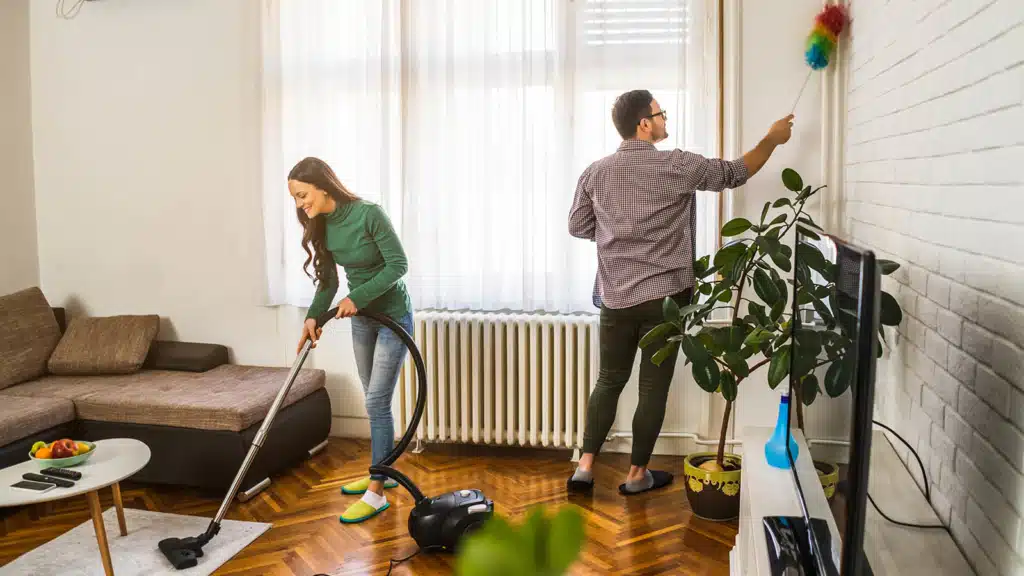 go back
go back
 go back
go back
More than just an annoyance
Dust, a common household foe, is inescapable no matter how clean you keep your home. That’s because dust is everywhere, and it accumulates quickly.
For those living with allergies, dust is more than an unsightly annoyance in an otherwise clean home. It can be a trigger for allergy symptoms—especially for those with sensitization to dust mite allergy.
What Is the Main Source of Dust?
Dust is made up of tiny pieces of things that can be found both inside and outside your home. People often think that dust is mostly made up of dead skin cells, but only about one-third of household dust is made up of skin cells. The rest of dust is made up of things like hair, dirt, pollen, bacteria, dust mites, clothing fibers, parts of dead insects (especially cockroaches), and skin cells.
Dust Allergy Symptoms
For those with allergies to components of dust, like animal dander, dust mites, cockroach, pollens, and mold, symptoms upon exposure can include: wheezing or shortness of breath, sneezing, coughing, chest tightness and more.
For a full list of symptoms, visit our Dust Mite Allergy page.

What Triggers a Dust Allergy?
These are the most prevalent dust allergy triggers:
- Pet dander: As much as we love our pets, their dander can cause issues for people with sensitizations. Pet dander, urine, and saliva can cause an allergic reaction.
- Dust mites: These microscopic spider-like pests are the main culprit of a household dust allergy. Pillows, curtains, carpeting, mattresses, and other upholstered furniture usually contain dust mite particles, which can cause allergic reactions.
- Pollen: We associate pollen with flowers, grasses, and weeds. But pollen is often found in household dust.
- Mold: Mold can live pretty much anywhere, from leaves in the forest to underneath the bathroom sink. Household dust can contain mold spores and particles.
- Cockroaches: Tiny cockroach particles, which are commonly found in dust, have allergens that can act similarly to the ones found in dust mites.
When Should I See A Doctor?
You should see a doctor for your dust allergy if you are experiencing any of the above symptoms, especially if severe or not controlled by over-the-counter medications.
Respiratory symptoms, like wheezing, shortness of breath, or persistent cough, are especially concerning. In addition, some allergy symptoms are similar to those of a cold, but if they last longer than a week, you may have an allergy.
Make an AppointmentHow to Avoid Dust Mites and Minimize Dust
According to the Allergy and Asthma Network, about 20 million Americans have an allergy to dust mites. While it’s nearly impossible to avoid dust and dust mites, there are steps you can take to help control your allergy. Here are just a few:
- Bust the dust. Use a damp cloth to remove dust on surfaces throughout your home without making them airborne. Rugs should be vacuumed once or twice a week. Use a vacuum with a HEPA filter, which stands for “high-efficiency particulate air”.
- Invest in allergen-proof bedding. Consider buying allergen-blocking or dust-proof covers for your pillows and mattresses. The tightly woven fabric, which should encase the entire mattress and pillow, will trap dust mites in the mattress/pillow and prevent dust mites from coming into contact with you.
- Cut carpet. Dust mites love a carpeted habitat. Replacing carpet with tile, wood, vinyl or linoleum flooring can help.
- Lower humidity. If you can, keep humidity below 50%, using a dehumidifier or air conditioner.
- HEPA filters.In your heating and cooling unit, put a HEPA filter with a MERV rating of 11 to 13. On the packaging, you can find the rating. Change the filter every three months.
Visit our Dust Mite Allergy page for our full list of prevention tips.
Dust Mite Allergy Treatment
Like all allergies, limiting your exposure to the allergen – in this case dust mites – is the first step to prevention. Unfortunately, it is nearly impossible to get rid of all dust mites.
However, our allergy specialists also offer more advanced treatments that include immunotherapy (allergy shots and sublingual immunotherapy) and prescription medications.
Although lacking long-term benefit, over-the-counter allergy medicines may help alleviate dust mite allergy symptoms and include:
- Oral Antihistamines: Can help with allergy symptoms like a runny or stuffy nose, sneezing, itchy eyes, and sneezing.
- Nasal Steroid Sprays: Can help reduce swelling in the nose and upper airways and, in some cases, ease eye symptoms.
- Oral Decongestants: Can help relieve a stuffy nose

Medically Reviewed By: Amy Parker, MD
Reviewed on: Jan. 29, 2023
Our team of writers, editors, and medical experts goes over each article carefully to make sure the information is correct and that only reliable sources are used.
We regularly check to see if the info in this article matches up with the latest scientific research and expert advice so that we can give you the most up-to-date information. See list of trusted resources here.
Get Help Managing Your Allergies
Work with one of our allergy specialists to develop a unique treatment plan for dust and other allergens you may have.
Make an Appointment